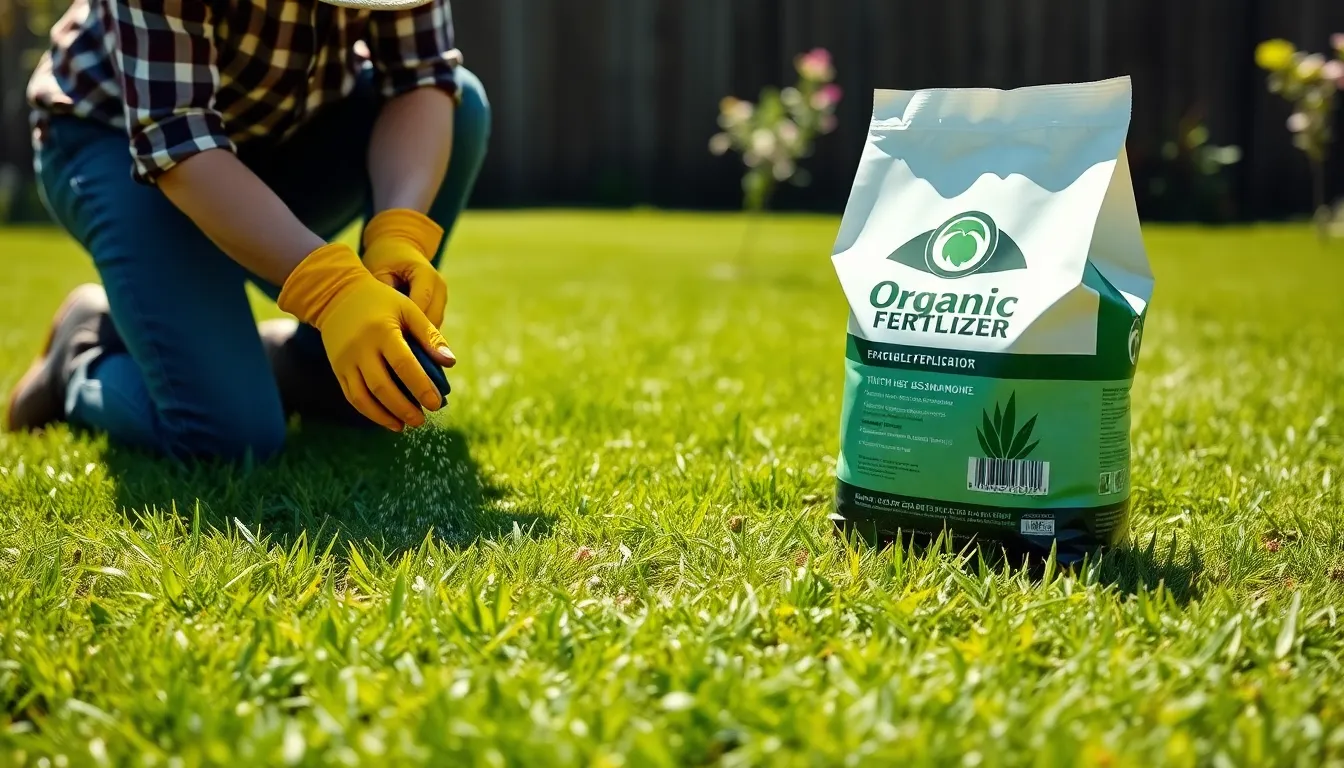Table of Contents
ToggleA lush green lawn isn’t just a pretty sight; it’s a status symbol. Who wouldn’t want to be the envy of the neighborhood with a carpet of vibrant grass? But achieving that picture-perfect yard requires more than just water and sunshine. Enter lawn fertilization—the secret sauce to transforming a lackluster lawn into a verdant paradise.
Overview of Lawn Fertilization
Lawn fertilization plays a crucial role in maintaining a healthy, attractive yard. This practice involves applying nutrients to the soil to promote grass growth and enhance color. Key nutrients include nitrogen, phosphorus, and potassium, with each serving a specific purpose.
Effective fertilization encourages deep root development, making grass more resilient against drought and pests. Seasonal timing affects the efficacy of application. Spring fertilization supports early growth, while fall application helps prepare the lawn for winter dormancy.
Organic and synthetic fertilizers are available in various forms. Organic options include compost and manure, which improve soil health over time. Conversely, synthetic fertilizers provide a quick nutrient boost for rapid growth.
Understanding soil testing is essential for optimal fertilization. Conducting a soil test reveals nutrient levels and pH, allowing for tailored fertilization. Recommended specific nutrient ratios ensure that the grass receives the necessary elements without over-fertilization.
Implementation techniques matter for successful results. Spreaders offer even distribution of fertilizers; hand application may lead to uneven coverage. Following package instructions on application rates ensures the lawn benefits without risking damage.
Regular maintenance complements fertilization efforts. Mowing and watering also contribute to lawn health and enhance the effects of fertilizer. Following best practices, homeowners can achieve the lush, vibrant lawns that serve as neighborhood highlights.
Types of Lawn Fertilizers

Lawn fertilizers fall into two primary categories: organic and synthetic. Each type offers unique benefits that cater to different lawn care needs.
Organic Fertilizers
Organic fertilizers derive from natural sources such as compost, manure, and plant materials. They enhance soil health over time by improving soil structure and increasing microbial activity. Compost enriches the soil, offering a slow-release source of nutrients. Numerous studies show that organic options promote beneficial organisms, such as earthworms, which improve soil aeration and drainage. Organic fertilizers encourage sustainable practices, aligning with environmentally conscious gardening. For optimal use, applying organic fertilizers during the growing season boosts nutrient availability.
Synthetic Fertilizers
Synthetic fertilizers contain chemically formulated nutrients designed for rapid absorption. These fertilizers typically feature higher concentrations of essential nutrients like nitrogen, phosphorus, and potassium. Immediate-release formulas address nutrient deficiencies and support quick grass growth. Lawn care experts often recommend synthetic options for their precise nutrient ratios, allowing for tailored applications based on soil tests. Despite their efficiency, synthetic fertilizers require cautious application to prevent nutrient runoff into waterways. Regular soil testing ensures proper balance, ensuring a healthy lawn without environmental impact.
Benefits of Lawn Fertilization
Lawn fertilization offers numerous advantages that enhance both the appearance and health of grass. Increased nutrient availability promotes robust growth and vibrant color, transforming ordinary lawns into stunning landscapes.
Improved Grass Health
Enhanced nutrient levels contribute significantly to grass vitality. Nitrogen fuels leafy growth, while phosphorus encourages root establishment and flowering. Potassium strengthens grass against environmental stresses. Regular fertilization supports thick turf, reducing weed invasion. Healthier grass withstands pests and diseases more effectively, leading to a greener, denser lawn. Consistently applying fertilizers that suit grass types and soil conditions maintains optimal nutrient balance. Soil testing reveals specific nutrient deficiencies, allowing tailored fertilization plans. A thriving lawn becomes resilient to wear from foot traffic and drought, creating an appealing outdoor space for relaxation and recreation.
Increased Lawn Resilience
Fertilization boosts lawn resilience against adverse conditions. Stronger roots penetrate deeper into the soil, accessing moisture and nutrients efficiently. A well-fertilized lawn exhibits improved drought resistance, surviving dry spells with minimal stress. Enhanced nutrient absorption aids in recovering from environmental challenges, including extreme temperatures. Fertilized grass also exhibits greater disease resistance, protecting it from common lawn diseases. Timely applications before seasonal shifts, like early spring and late summer, prepare the lawn for weather transitions. Ultimately, resilient lawns remain lush and healthy, serving as a source of pride for homeowners and focal points in neighborhoods.
Best Practices for Lawn Fertilization
Lawn fertilization requires attention to detail for optimal results. Proper timing and application methods play a significant role in promoting healthy grass growth.
Timing and Frequency
Spring and fall represent the ideal times for fertilization. Spring applications support initial growth during the active growing season. In contrast, fertilizing in fall prepares the lawn for winter dormancy. Homeowners should perform soil testing to determine nutrient needs, allowing for more tailored fertilization. A typical schedule includes fertilizing every 6 to 8 weeks during peak growth periods. Regular intervals help maintain consistency in nutrient supply, maximizing grass health.
Application Methods
Several application methods exist, each offering unique advantages. Using a spreader ensures even distribution, preventing brown spots and nutrient runoff. Homeowners might choose a drop spreader for precision or a broadcast spreader for larger areas. Following package instructions is crucial for avoiding over-fertilization. Hand-held spreaders or liquid fertilizers can work well for smaller lawns or specific areas. Ensuring adequate watering post-application also helps nutrients penetrate the soil effectively, enhancing absorption.
Common Mistakes to Avoid
Overlooking soil testing presents a significant mistake in lawn fertilization. It’s essential to analyze soil nutrient levels to tailor fertilization accordingly. Skipping this step often leads to imbalanced nutrient applications, which hampers grass health.
Applying fertilizer at incorrect times affects the lawn’s growth. Fertilizing during extreme heat or drought can stress grass, while late fall applications risk nutrient runoff. Following the recommended schedule of spring and fall fertilization ensures optimal growth.
Using excessive amounts of fertilizer causes more harm than good. Over-fertilization can burn grass and lead to nutrient leaching, ultimately damaging local waterways. Applying the right amount based on package instructions mitigates this risk.
Ignoring proper application methods can result in uneven distribution. Utilizing a spreader promotes even coverage, minimizing both waste and damage. Failing to do so often leads to patchy growth and areas of under-fertilization.
Neglecting post-application care diminishes fertilizer effectiveness. Adequate watering after fertilization plays a crucial role in nutrient absorption. Skipping this step can limit the availability of nutrients to grass.
Assuming all fertilizers are the same overlooks the unique characteristics of organic and synthetic options. Each type serves specific needs, with organic fertilizers improving soil health over time and synthetic options delivering quick nutrients. Choosing the right type based on lawn needs maximizes results.
Postponing lawn maintenance tasks risks diminishing fertilization benefits. Practices like regular mowing and watering complement fertilization efforts, ensuring a healthy lawn. Consistently following these practices leads to vibrant, resilient grass that stands out in the neighborhood.
Lawn fertilization is a vital practice for homeowners looking to achieve a stunning and healthy yard. By understanding the specific nutrient needs of their grass and the importance of timing, they can create a lush landscape that thrives through all seasons. Whether opting for organic or synthetic fertilizers, choosing the right type and applying it correctly ensures optimal results.
Regular maintenance and tailored fertilization plans not only enhance the lawn’s resilience but also contribute to its overall beauty. With the right approach, homeowners can take pride in a vibrant lawn that stands out in the neighborhood, showcasing their commitment to outdoor aesthetics and environmental health.




